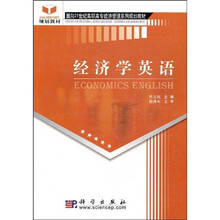面向21世纪高职高专经济管理系列规划教材:经济学英语

目 录内容简介
Chapter 1 Ten Principles of Economics
Principle 1 People face tradeoffs
Principle 2 The cost of something is what you give to get it
Principle 3 Rational people think at the margin
Principle 4 People respond to incentives
Principle 5 Trade can make everyone betteu off
Principle 6 Markets are usually a good way to organize economic activity
Principle 7 Governments can sometimes improve market out comes
Principle 8 A countrys standard of living depends on its to produce goods and services
Principle 9 Prices rise when the government prints too much money
Principle 10 Society faces short-run tradeoff between inflation and unemployment
Questions for review
Chapter 2 Interpendence and the Gains from Trade
A parable for the modern economy
The need and motivation for international trade
Absolute advantate and comprative advantage
The legacy of adam smith and david ricardo
Questions for review
Chapter 3 The Market Forces of Supply and Demand
The determinants of individual demand
The demand schedule and the demand curve
Shifts in the demand curve
The determinants of ivdividual srpply
The supply schedule and the supply curve
Market supply versus individual supply
Shifts in the supply curve
Equilibrium
Market supply versus individual supply
Shifts inthe supply curve
Equilibrium
Three steps to analyzing changes in equilibrium
Conclusion: How price allocate resources
Question for review
Chapter 4 Elasticity and Its Application
The elasticity of demand
The elasticity of supply
Applications of supply, demand, and elasticiy
Questions for review
Chapter 5 Supply, Demand, and Government Policies
Controls on prices
Taxes
Conclusion
Questions for review
Chapter 6 Production Costs
The production function
Variable costs versus fixed costs
Production decisions in the Short run and long run
Diminishing returns in production
Maximizing profit and the production decision
Economies and diseconomies of scale
The experience curve
Optimal scale and X-inefficiency
Conclusion
Chapter 7 Consumers, Producers, and the Efficiency of Markets
Consumer surplus
Producer surplus
Market efficiency
Conclusion
Questions for review
Chapter 8 The Costs of Taxation
The deadweight loss of taxation
The determinants of the deadweight loss
Deadweight loss and tax revenue as taxes vary
Conclusion
Questions for review
Chapter 9 Public Goods and Common Resources
The different kinds of goods
Public goods
Common Resources
Questions for review
Chapter 10 Measuring a Nations Income
The economys income and expenditure
The measurement of gross domestic product
The components of GDP
Real versus nominal GDP
GDP and economic weU-being
Conclusion
Questions for review
Chapter 11 Aggregate Demand and Aggregate Supply
Three key facts about economic fluctuations
Explaining short-run economic fluctuations
The aggregate-demand curve
The aggregate-supply curve
Two causes of recession
Conclusion: The orgins of aggregate demand and aggregate supply
Questions for review
Chapter 12 Management of the Economy I : Fiscal Policy
The essence of fiscal policy
Problems with fine-tuning aggregate demand
Government borrowing
Conclusion
Chapter 13 Management of the Economy Ⅱ: Monetary Policy
The essence of monetary policy
Principles of monetarism
Measuring the money supply
The effects of monetary policy on business
Conclusion
……
Principle 1 People face tradeoffs
Principle 2 The cost of something is what you give to get it
Principle 3 Rational people think at the margin
Principle 4 People respond to incentives
Principle 5 Trade can make everyone betteu off
Principle 6 Markets are usually a good way to organize economic activity
Principle 7 Governments can sometimes improve market out comes
Principle 8 A countrys standard of living depends on its to produce goods and services
Principle 9 Prices rise when the government prints too much money
Principle 10 Society faces short-run tradeoff between inflation and unemployment
Questions for review
Chapter 2 Interpendence and the Gains from Trade
A parable for the modern economy
The need and motivation for international trade
Absolute advantate and comprative advantage
The legacy of adam smith and david ricardo
Questions for review
Chapter 3 The Market Forces of Supply and Demand
The determinants of individual demand
The demand schedule and the demand curve
Shifts in the demand curve
The determinants of ivdividual srpply
The supply schedule and the supply curve
Market supply versus individual supply
Shifts in the supply curve
Equilibrium
Market supply versus individual supply
Shifts inthe supply curve
Equilibrium
Three steps to analyzing changes in equilibrium
Conclusion: How price allocate resources
Question for review
Chapter 4 Elasticity and Its Application
The elasticity of demand
The elasticity of supply
Applications of supply, demand, and elasticiy
Questions for review
Chapter 5 Supply, Demand, and Government Policies
Controls on prices
Taxes
Conclusion
Questions for review
Chapter 6 Production Costs
The production function
Variable costs versus fixed costs
Production decisions in the Short run and long run
Diminishing returns in production
Maximizing profit and the production decision
Economies and diseconomies of scale
The experience curve
Optimal scale and X-inefficiency
Conclusion
Chapter 7 Consumers, Producers, and the Efficiency of Markets
Consumer surplus
Producer surplus
Market efficiency
Conclusion
Questions for review
Chapter 8 The Costs of Taxation
The deadweight loss of taxation
The determinants of the deadweight loss
Deadweight loss and tax revenue as taxes vary
Conclusion
Questions for review
Chapter 9 Public Goods and Common Resources
The different kinds of goods
Public goods
Common Resources
Questions for review
Chapter 10 Measuring a Nations Income
The economys income and expenditure
The measurement of gross domestic product
The components of GDP
Real versus nominal GDP
GDP and economic weU-being
Conclusion
Questions for review
Chapter 11 Aggregate Demand and Aggregate Supply
Three key facts about economic fluctuations
Explaining short-run economic fluctuations
The aggregate-demand curve
The aggregate-supply curve
Two causes of recession
Conclusion: The orgins of aggregate demand and aggregate supply
Questions for review
Chapter 12 Management of the Economy I : Fiscal Policy
The essence of fiscal policy
Problems with fine-tuning aggregate demand
Government borrowing
Conclusion
Chapter 13 Management of the Economy Ⅱ: Monetary Policy
The essence of monetary policy
Principles of monetarism
Measuring the money supply
The effects of monetary policy on business
Conclusion
……
目 录内容简介
《经济学英语》内容具有连贯性、系统性和一定的完整性,材料取舍以实用为准、够用为度,所选材料均为理解和解释经济现象以经济政策的核心内容,这也正是《经济学英语》不同于一般同类专业英语教材之处。读者通过对《经济学英语》的学习,不仅学掌握一定数量的英语词汇,而且能了解西方经济学的基本理论。《经济学英语》既可作为经济管理类学生的专来英语教材,也可作为西方经济学的双语教材。对于具有一定英语基础又想通过英语原始文献了解西方经济学的读者,《经济学英语》也是一本合适的入门读物。
比价列表
公众号、微信群
 缺书网
缺书网微信公众号
 扫码进群
扫码进群实时获取购书优惠






